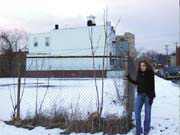As abandoned lots in Jersey City become history because of increasing development, the Jersey City Landmark Conservancy has to create literal “history gardens” in five of them.
The JCLC will transform abandoned lots into parks, celebrating the area’s history and creating a garden and courtyard for community events in the Lafayette, Downtown, Journal Square, the Heights, and Greenville communities.
“A history garden is a new thing,” said Dianna Guadagnino, who is spearheading the History Garden that will be built in Lafayette. “This will really educate people. People will be able to understand the rest of the city. It’s important to get these gardens because if everything is new in 50 years, future generations won’t have a sense of history.”
The JCLC will create the history gardens one district at a time, starting with Lafayette, at the southwest cornet of Monitor and Maple Streets. Since the concept is new and each neighborhood unique, future history gardens will conceptually combine what worked with prior creations with the goals of the district.
A community centerpiece
Although JCLC will oversee the sites, they will be created in a group effort. The Lafayette History Garden will be directed by Guadagnino and four other committee members. Local artists, schoolchildren and other community people will help.
“There are so many people who want to help because so many people care about history and preservation in Jersey City,” said Guadagnino. “It’s going to be a place to come together.”
Like any community garden, the history gardens will have plants, flowers, walking paths and benches. There will also be a central courtyard for block parties, lectures, plays and film festivals. Architectural salvage pieces located throughout the park will make up the parks’ historic component.
“[Architectural salvage pieces] are pieces of buildings that have been torn down,” said JCLC President Gomez. “So we salvage the pieces. Many of them are made of terra cotta, a soft stone that’s baked in oven with a special glaze that will make it last. It lasts up to two centuries.”
Salvage pieces also include pieces of brick, limestone, metal and ornamental iron gates.
One of the architectural salvage highlights in the Lafayette History Garden include a five ton tile and brick sign from the Jersey City Machine Works building which was previously located on Grand Street before being torn down a number of years ago.
Another item will be a number of 20-foot-tall ornamental iron light poles weighing two tons dating from 1919. PSE&G will salvage the poles when they replace them with new modernized poles.
Gomez contacted PSE&G Public Affairs Manager Richard Dwyer about the poles during the company’s 100th anniversary year.
“PSE&G was founded on the premise to help make New Jersey a better place to live,” said Dwyer. “Since PSE&G was celebrating its 100th anniversary, the timing allowed us to more than reuse and recycle a product, but to recapture the histories relevance of the poles’ artistry and workmanship, and to add an old fashioned ambiance to the garden’s natural landscape.”
Display panels adorning a perimeter fence will tell the story of local landmarks and famous people, allowing visitors to walk the perimeter and learn Lafayette’s history.
Henry Hudson, the Marques de Lafayette (for whom the district was named in 1856) and local community leaders will be named, among others.
The display panels will be designed by local artists and students from P.S. 22 and All Saints elementary schools.
“Creating the board is going to teach the school kids what it means to build a community,” Guadagnino said.
A long diverse history
According to Gomez, the JCLC chose Lafayette to be first because it is the oldest neighborhood in Jersey City and even New Jersey.
For Guadagnino the Lafayette Historical Garden will illustrate the multi-cultural history of Lafayette.
The Underground Railroad for escaped slaves ran through the area, and a slave burial ground exists under a basketball court. Lafayette is also the state’s oldest African American neighborhood.
Communipaw Road itself was originally built by Native Americans, and was the site of the last stand of the Lene Lenape tribe.
“There were women and children in that last stand with the Dutch,” said Guadagnino. “The last of the Indians died or were slaughtered. We’re dedicating the garden to those women and children who died there.”
Lafayette was also the landing site of this country’s first Dutch settlers.
“In 1609, Henry Hudson docked his ship, the Half Moon, in Comminipaw Cove,” said Gomez. “In 1612, the first Dutch settlers came to Lafayette. Communipaw [the former name of Lafayette] is older than Manhattan. People settled here first and then went over to Manhattan.”
Author Washington Irving once referred to the area as the egg from which Manhattan was hatched, said Gomez. “Bringing the history of the people is going to unite everybody,” said Guadagnino. “The conservancy is about the things that tell a story. It helps to preserve community to say the buildings tell a story.”
The Jersey City Department of Public Works will help remediate the site, removing asphalt and providing trees, fencing and electricity.
Guadagnino hopes to create the park in phases, to insure a good job.
Construction will begin this spring. The JCLC will hold a dedication in May, during Preservation Month.
